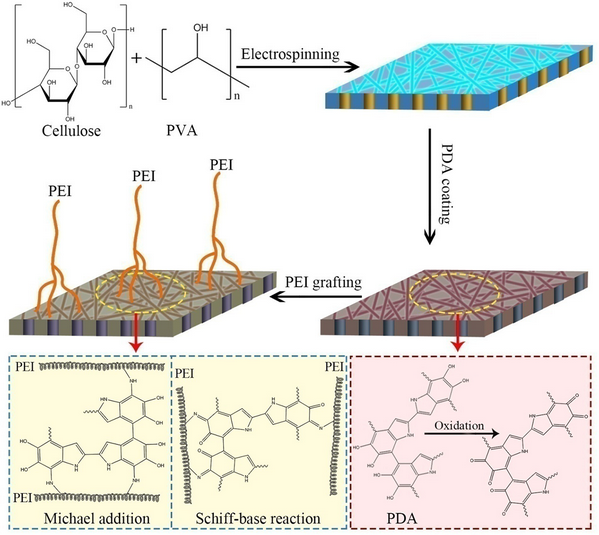Crossref Citations
This article has been cited by the following publications. This list is generated based on data provided by
Crossref.
Li, HongYan
Li, Qi
Liu, HongLi
Cao, Kai
Zhang, PengYu
Liu, Tong
Wang, DongMei
Liao, XiaoLan
and
Wei, DongQing
2020.
Fabrication of anti-icing surface with halloysite spherical microcapsule.
Journal of Materials Research,
Vol. 35,
Issue. 21,
p.
2887.
Burghaus, U.
2021.
Adsorption of water on epitaxial graphene.
Journal of Materials Research,
Vol. 36,
Issue. 1,
p.
129.
He, Jinmei
Wang, Rong
Pang, Yajie
Luo, Zhanxia
He, Dan
Sun, Wenchao
Shi, Fan
Peng, Lei
and
Qu, Mengnan
2021.
A facile preparation of robust superhydrophilic and underwater superoleophobic copper foam for high efficiency and repeatable oil–water separation.
Surface and Interface Analysis,
Vol. 53,
Issue. 11,
p.
963.
Fürtauer, Siegfried
Hassan, Mostafa
Elsherbiny, Ahmed
Gabal, Shaimaa A.
Mehanny, Sherif
and
Abushammala, Hatem
2021.
Current Status of Cellulosic and Nanocellulosic Materials for Oil Spill Cleanup.
Polymers,
Vol. 13,
Issue. 16,
p.
2739.
Zhao, Xue-Qing
Wahid, Fazli
Cui, Ji-Xiao
Wang, Yun-Ya
and
Zhong, Cheng
2021.
Cellulose-based special wetting materials for oil/water separation: A review.
International Journal of Biological Macromolecules,
Vol. 185,
Issue. ,
p.
890.
Pan, Lei
Xue, Pengbo
Wang, Menglin
Wang, Fei
Guo, Huaxin
Yuan, Xiaosa
Zhong, Lang
and
Yu, Jia
2021.
Novel superhydrophobic carbon fiber/epoxy composites with anti-icing properties.
Journal of Materials Research,
Vol. 36,
Issue. 8,
p.
1695.
Burghaus, U.
2021.
Adsorption of water on epitaxial graphene.
Journal of Materials Research,
Vol. 36,
Issue. 1,
p.
129.
Angel, Nicole
Li, Songnan
Yan, Feng
and
Kong, Lingyan
2022.
Recent advances in electrospinning of nanofibers from bio-based carbohydrate polymers and their applications.
Trends in Food Science & Technology,
Vol. 120,
Issue. ,
p.
308.
Xiang, Bin
Shi, Guogui
Mu, Peng
and
Li, Jian
2022.
Eco-friendly WBF/PAN nanofiber composite membrane for efficient separation various surfactant-stabilized oil-in-water emulsions.
Colloids and Surfaces A: Physicochemical and Engineering Aspects,
Vol. 645,
Issue. ,
p.
128917.
Renkler, Nergis Zeynep
Cruz-Maya, Iriczalli
Bonadies, Irene
and
Guarino, Vincenzo
2022.
Electro Fluid Dynamics: A Route to Design Polymers and Composites for Biomedical and Bio-Sustainable Applications.
Polymers,
Vol. 14,
Issue. 19,
p.
4249.
Mizan, Md Mizanul Haque
Gurave, Pramod M.
Rastgar, Masoud
Rahimpour, Ahmad
Srivastava, Rajiv K.
and
Sadrzadeh, Mohtada
2023.
“Biomass to Membrane”: Sulfonated Kraft Lignin/PCL Superhydrophilic Electrospun Membrane for Gravity-Driven Oil-in-Water Emulsion Separation.
ACS Applied Materials & Interfaces,
Vol. 15,
Issue. 35,
p.
41961.
Li, Minglun
Loccufier, Eva
Geltmeyer, Jozefien
D’hooge, Dagmar R.
De Buysser, Klaartje
and
De Clerck, Karen
2024.
Playing with Chlorine-Based Post-modification Strategies for Manufacturing Silica Nanofibrous Membranes Acting as Stable Hydrophobic Separation Barriers.
Advanced Fiber Materials,
Vol. 6,
Issue. 1,
p.
145.
Wu, Jiangqin
Xue, Qianwen
Zhang, Yuxuan
Lv, Zaosheng
Huang, Yanfen
and
Lei, Yang
2024.
Semi-IPN hydrogel-modified stainless-steel mesh mixed with SiO2 is used for oil–water separation.
Journal of Coatings Technology and Research,
Vol. 21,
Issue. 6,
p.
2129.
Wu, Wei
Ma, Xiaoqian
Wang, Rui
and
Zhang, Dayong
2024.
Green preparation of Fe3O4/HA/CS magnetic nanoparticles for oil–water separation.
Journal of Chemical Technology & Biotechnology,
Vol. 99,
Issue. 7,
p.
1637.
Balakrishnan, Manikandan
Sundaramoorthy, Krishnamohan
and
Ramasamy, Anbarasan
2025.
Azadirachta indica seed powder–reinforced and nano sand–filled USPER membrane for oil/seawater separation.
Biomass Conversion and Biorefinery,
Vol. 15,
Issue. 3,
p.
4759.
